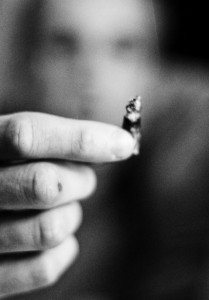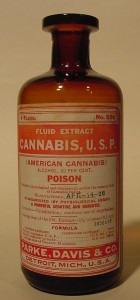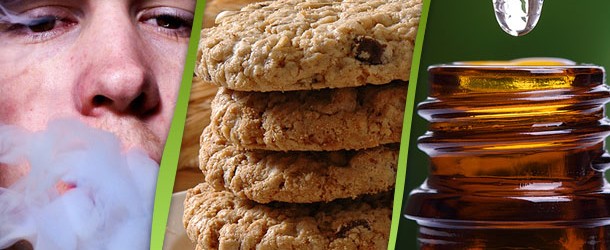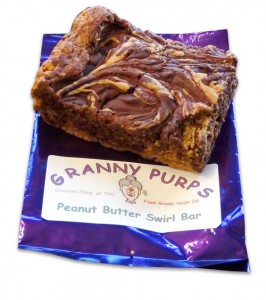Cannabis dispensaries are increasingly offering a wide variety of edible goods made from marijuana, in addition to a growing assortment of cannabis concentrates and buds. With all these options, medical marijuana users face some real choices about how best to use cannabis to treat their medical conditions.
Smoking Cannabis

Photo By: Shawn-Tron
Inhaling cannabis smoke from a joint, pipe, or bong is a quick and effective way to introduce cannabinoids into the bloodstream and the associated cannabinoid receptors in the brain. The psychoactive effects known as the “high†are usually noticeable within one to three minutes and generally last for two and three hours. Many medical cannabis users prefer smoking cannabis because the effects are so quickly noticeable making the dosage relatively easy to gauge. Laboratory testing enables dispensaries to accurately determine marijuana potency and help provide dosing estimates to patients.
Health Effects of Smoking Cannabis
Unfortunately inhaling smoke is not the most healthy method of consuming cannabis. While there is still no conclusive correlation between the effects of smoking cannabis and an increased incidence of lung cancer, this is likely due, in part, to the difficulty in finding subjects with a history of long term cannabis use but no history of smoking tobacco.
In September of 2011, the University of Colorado Cancer Center released a paper stating, “There is little direct evidence that THC or other cannabinoids are carcinogenic”. This means that THC on its own is not a cancer causing compound. The article goes on to state that, at least in rodent test subjects, “cannabis smoke is carcinogenicâ€. In other words, the smoke from burning cannabis is carcinogenic, not the plant itself.
While the debate over cannabis smoke and lung cancer is far from over, long term exposure to cannabis smoke is shown to accelerate the decline in pulmonary function. For some medical marijuana patients the increase in the quality of life associated with smoking cannabis is worth the long term risk of inhaling smoke. For others, especially those already experiencing throat and lung problems, cannabis smoke can cause irritation and exacerbate or complicate existing medical problems.
Luckily there are other options available to those who choose to use medical cannabis but wish to avoid or decrease exposure to cannabis smoke.
Hash, Kief and other Concentrates
One simple method of decreasing the amount of inhaled smoke is to increase the potency of the product. Hashes, kiefs, and other cannabis derived concentrates allow medical cannabis users to smoke less plant material while still consuming high levels of cannabinoids. Though this still requires the inhalation of smoke, one “hit†of hash may be equivalent to 6 or more hits of cannabis bud.
Pros:
- Quick to take effect
- Relatively easy to judge dosage
- Predictable 2 to 3 hours of relief
Cons:
- Inhalation of smoke, tar and carbon monoxide
- Short 2 to 3 hours high requires continued use throughout the day or night.
- Possible inhalation of mold spores
- Marijuana smoke odor draws attention and limits the places you can medicate
- Dangerous to travel with by car or air
- May result in inhalation of butane from lighters or chemicals from burning matches
Vaporizing Cannabis
Many medical cannabis users have begun vaporizing cannabis instead of smoking it. Vaporization, or volatilization, is a process in which the cannabinoids are released in gas form through the application of heat without combustion. Because the buds or concentrates are never burnt, vaporization produces none of the byproducts of combustion like carbon monoxide and tar. The released vapor is also much cooler than smoke, making it less damaging to lung and throat tissue.
Cannabis Edibles
An increasing number of medical marijuana users are finding the advantages of cannabis infused foods known as “edibles†to treat their medical conditions. Unlike smoking cannabis, edibles are introduced to the body through the gastrointestinal tract and processed by the liver before entering the blood steam The liver changes the cannabinoid THC into the more potent 11-hydroxy-THC which tends to have a stronger more sedative effect. This makes cannabis edibles especially suitable for patients with sleep disorders caused by pain or general insomnia. Patients ingesting cannabis will often feel the effects within 45 to 90 minutes with a high lasting between 6 to 10 hours.
Edibles are generally sold as high calorie treats like cookies, candies and brownies made by infusing butter or cooking oil with cannabis. The cannabis infused butter is then added to a traditional recipe. Edibles made from marijuana leaf and bud often have a distinct taste and a green tinge from the plants chlorophyll. Edibles made from concentrates like hash oil often have a less noticeable taste and color. Medical marijuana users who prefer to keep the calorie count under control sometimes dip bread in marijuana butter or oil, or use it in healthy recipes.
Dosage
One of the most common complaints with cannabis edibles is their often unpredictable strength. Though one dose of an edible should contain about 20 mg of pure THC, the strength of an edible is determined by the quality and quantity of the marijuana used to create it. The slow onset of cannabis edibles can create even more confusion. Impatient users looking for relief from their symptoms often do not wait long enough and eat more before feeling the effects of the first dose. When in doubt, always start with a small dose and wait at least 90 minutes before eating more. To maintain a consistent dosage between batches, edibles should be made from a consistent source of laboratory tested marijuana with a known cannabinoid potency.
Health Effects and Cannabis Edibles
Because cannabis edibles are ingested instead of smoked, all of the harmful side affects associated with smoking are eliminated. Though some users have described feeling nauseous or groggy, and on rare occasions, vomiting. There are no known long term negative side affects from ingesting cannabis edibles.
Pros:
- None of the known health problems associated with smoking cannabis
- Can be consumed anywhere without being conspicuous
- Edibles are easy to travel with since law enforcement rarely thinks to look for edibles
- Longer lasting effects don’t require continued dosing throughout the day or night
Cons:
- May not be suitable for patients experiencing nausea or lack of appetite
- Edibles often contain large quantities of empty calories from sugar, fat, and other highly processed ingredients.
- Long lasting effect (6-10 hours) may not be suitable for every situation
- Edibles must be kept away from children or others who may unknowingly consume the cannabis.
- Patients must wait for up to an hour before relief from their symptoms Â
- Slow onset can lead patients to eat more than is needed resulting in discomfort
- Appropriate dosage is often unknown
 Cannabis Tinctures
Cannabis Tinctures
Cannabis infused tinctures became common in the 1840’s after an article was published by Dr. Walter O’Shaughnessy, “On The Preparations of the Indian Hemp, or Gunjah”. By the late 1800’s almost every major pharmaceutical company was producing cannabis tinctures. While not as popular today, cannabis tinctures are easy to make and offer a great alternative for medical marijuana patients.
Tinctures are usually an alcohol based solution of dissolved cannabinoids that can be taken as drops. If held under the tongue the drops are absorbed directly into the bloodstream and taken to the brain within minutes, much like smoking or vaporizing marijuana. Cannabis tinctures can also be added to food or drink so it can be processed by the liver in the same manner as eating cannabis edibles. THC is converted to 11-hydroxy-THC which takes more time to reach the brain, but delivers many more hours of relief.
It may take a bit of experimenting to figure out the proper quantity for treating your symptoms. Start out with only one or two drops and wait for the effects before taking more. Because tinctures are made of high proof alcohol they will evaporate if left uncovered. As the the percentage of alcohol to cannabis diminishes the potency of each drop will increase.
Pros:
- Fast or slow onset depending on how it is taken
- No calories like edibles
- No throat and lung irritation from smoking
- Easy to measure doses once the required number of drops is known
- Easy to conceal and travel with
- Can be used anywhere without notice
- Does not attract accidental use like edibles might
Cons:
- May conflict with some patients beliefs as it contains some amount of alcohol
- Some consider the taste to be quite unpleasant
- Alcohol can evaporate, increasing the strength of the the remaining tincture
- Dosage must be determined by gradual dosage increases until a desired dosage is determined
There is nothing wrong with experimenting to find what form of cannabis works best for you. Likely you will find that a combination of methods is required to treat your symptoms. Many users find that smoking or vaporizing work best during the day and edibles work best at night before bed. However you take your medicine, be sure to get it from a safe and consistent source.
How Best To Use Medical Marijuana: Smoking vs Edibles and Tinctures,














Rambo, if I wanted medical marijauana candy but wanted to save it for a special occasion, how long would It stay good?
Is anyone using hemp oil/ medical cannabis for epilepsy?